LNS Research has long been at the forefront of research on the Industrial Internet of Things (IIoT), Industry 4.0, and technologies’ impact on Industrial Transformation (IX). We were the first to define an IIoT Platform in 2015 and the first to show the path from business objectives to reference architectures through our Industrial Transformation framework. We introduced the IX Reference Architecture in 2020 and have since guided manufacturers toward how to reap the benefits of these new technologies.
The market continues to evolve, and we are seeing new, valuable technologies, platforms, and applications that simplify implementation and drive operational value. With market changes and technological advances, we have identified a need to update our IX Reference Architecture to match the needs of today’s manufacturers and the current offerings.
IX Reference Architecture Defined
The LNS Research Reference Architecture is a future-looking framework that categorizes the technological capabilities needed to deliver for all personas involved in manufacturing operations. While previous frameworks have been focused on core functions such as operations, quality, asset performance management, IT, and OT, our research shows that companies that successfully transform include a broader set of functional areas. Industrial operations have moved from a pure focus on cost reduction to a more extensive scope around profitability, sustainability, and the Future of Industrial Work (FOIW) lifecycle to achieve the vision of Operation 2030 and the Journey to Zero+.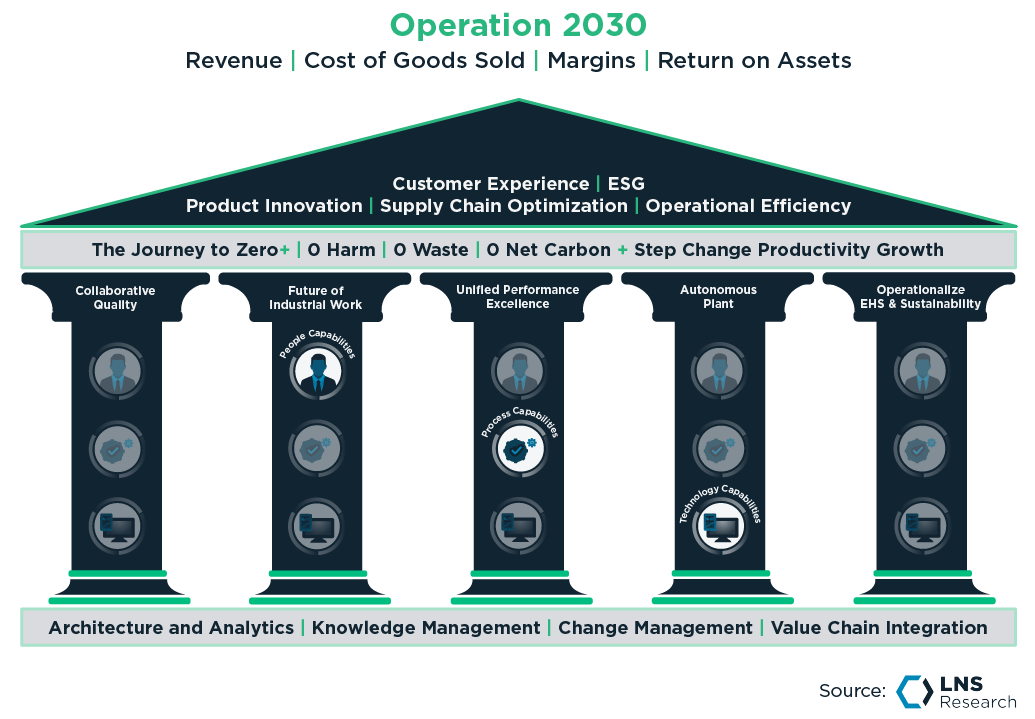 LNS Research sees five main categories of technologies that are critical in enabling manufacturers to transform and stay competitive. The categories are broad, and our research indicates that multiple vendors will be required to deliver all five categories.
LNS Research sees five main categories of technologies that are critical in enabling manufacturers to transform and stay competitive. The categories are broad, and our research indicates that multiple vendors will be required to deliver all five categories.
-
-
-
Industrial Applications: Software that drives specific business outcomes.
-
Industrial Application Platform: The common software capabilities used across many applications.
-
Industrial Cloud Infrastructure: Managed Cloud and Edge infrastructure services.
-
Industrial Networking & Compute: All the on-premises hardware not covered by the cloud infrastructure.
-
Ecosystem: Products and services that integrate and extend architecture.
Some of these categories are inclusive of others and have closer relationships.%20Reference%20Architecture%202024.png?width=680&height=713&name=LNS%20Research%20Industrial%20Transformation%20(IX)%20Reference%20Architecture%202024.png) The 2024 version maps more easily to the three architectural paths that we previously identified:
The 2024 version maps more easily to the three architectural paths that we previously identified: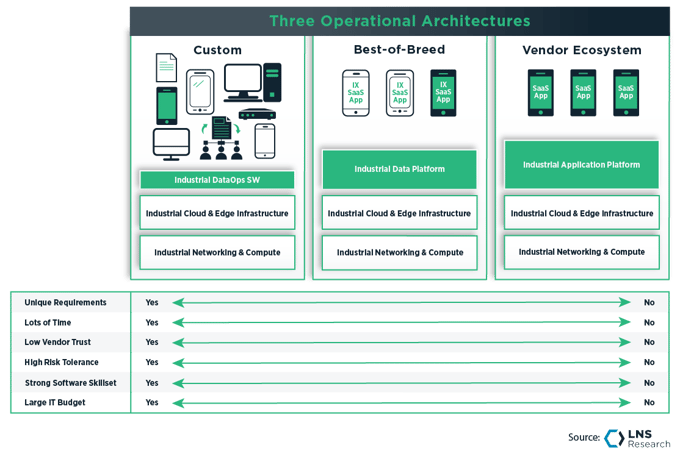 There is no overall right or wrong architectural path, but there are conditions that make some paths more attractive than others. We have provided a set of business characteristics that can be used as guidelines to select the best architectural approach.
There is no overall right or wrong architectural path, but there are conditions that make some paths more attractive than others. We have provided a set of business characteristics that can be used as guidelines to select the best architectural approach.
The new IX Reference Architecture simplifies the implementation choices:
-
-
-
All approaches require Industrial Applications.
-
Vendor ecosystem requires an Industrial Application Platform.
-
Best-of-Breed requires an Industrial Data Platform.
-
All approaches require an Industrial Cloud
Most implementations combine the three architectural approaches due to the need for legacy support and industry-specific functionality. This hybrid approach is one characteristic that makes an industrial architecture challenging to build.
The Categories
1. Industrial Applications
As mentioned above, Industrial Applications are software that drives specific business outcomes. While applications are at the top of the reference architecture, they are at the core of the user experience.
 2. Industrial Application Platform
2. Industrial Application Platform
The Industrial Application Platform (IAP) provides the common software capabilities used across many applications. We have identified the need for a specific Industrial Application Platform that provides a more holistic toolset than our previous Development Tools and Libraries categories. This need is based on the unique requirements related to industrial information systems.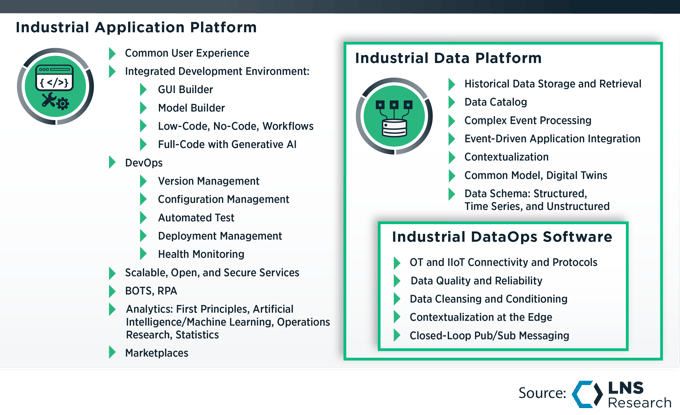
Industrial Data Platform
The need to include an Industrial Data Platform (IDP) is common to both industry-specific and generic platforms. The IDP provides all the tools for managing the data within the architecture. We have chosen to represent IDP as a platform within the platform as some suppliers have chosen to deliver IDP without full Industrial Application Platform capabilities. 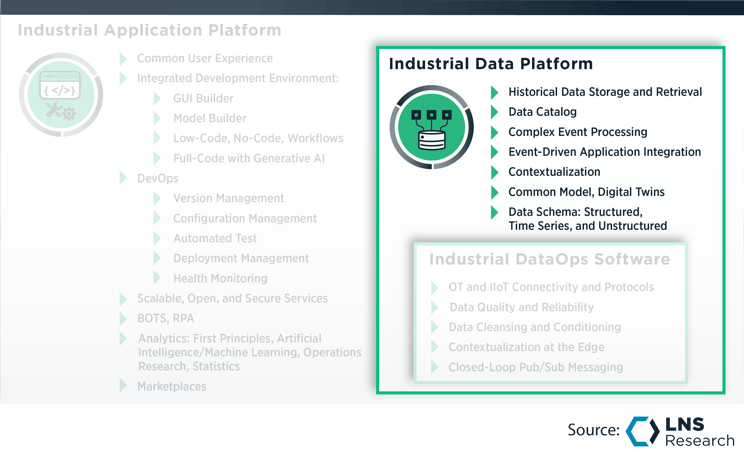 The Industrial Data Platform is responsible for organizing and managing the collection, cleansing, and contextualization of data across multiple applications.
The Industrial Data Platform is responsible for organizing and managing the collection, cleansing, and contextualization of data across multiple applications.
Industrial DataOps Software
Industrial DataOps Software (IDOS) is a subset of the Industrial Data Platform. This software represents the plumbing necessary to build automated data collection and closed-loop systems. The IT and OT communication protocols are at the core of this software. Traditionally, industrial controllers, instrumentation, and devices have communicated over proprietary or industry-specific protocols that had to be translated into more generally accessible IT protocols. While most modern devices use wired or wireless TCP/IP-based protocols, many devices in the field still require proprietary hardware and software to communicate. While the primary purpose is reliable communication data, the software also includes data quality, reliability, cleansing, conditioning, and contextualization.
While the primary purpose is reliable communication data, the software also includes data quality, reliability, cleansing, conditioning, and contextualization.
The Integrated Application Platform
Combining the Industrial Data Platform with the Industrial Application Platform makes it possible to build, organize, and manage applications and the data they share securely. The platform empowers industrial engineers to use previously published applications as well as build their own applications. Open and secure interoperability is at the core of the platforms. The applications can behave as services, sharing information between them and enriching the overall experience across all the applications.
The two platforms provide event-driven data transport, REST-based data access, and data workflow capabilities. These platforms are the core of the IX reference architecture; they enable strong collaboration between all functions involved in industrial operations and the external applications used by these functions.
3. Industrial Cloud Infrastructure
Industrial Cloud Infrastructure (ICI) consists of managed cloud and edge infrastructure services, fulfilling the industrial need for autonomous logic that can run everywhere. It, therefore, expands beyond the data centers managed by the Hyperscalers and often requires the management of cloud-integrated resources running on the edge. Vendor offerings increasingly allow users to deploy any functionality wherever they need or want.

4. Industrial Networking and Compute
Industrial Networking & Compute represents the on-premises hardware not covered by the cloud infrastructure. Due to the specific industrial needs listed above and the need for closeness to the physical processes, dedicated industrial network networking and computing are often needed outside the traditional Hyperscaler scope.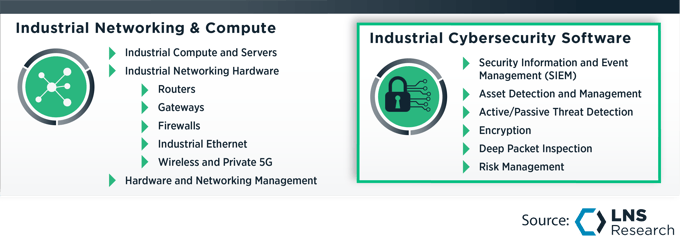
Industrial Cyber Security
OT often lacks modern tools for security. Many industrial automation systems rely on air gaps or network segregation to limit who can access their information. Integrating OT and IT is a critical part of building an IX architecture, and industrial networking and computing perform a critical role in achieving this integration. We have, therefore, chosen to call out Industrial Cyber Security as its own sub-group within industrial networking and computing. While Industrial cyber security overlaps with IT Cyber Security, it has specific requirements related to the hardening of OT equipment. 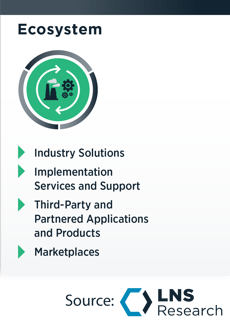
5. Ecosystems
The Ecosystem represents the products and services that integrate and extend architecture. So far, no single vendor has been able to deliver all the features most manufacturers need, and we expect that this situation will continue in the foreseeable future. Manufacturers do not like experimenting and assembling unknown solutions if proven solutions exist. A thriving ecosystem catalyzes such solutions, and vendors are working hard to establish ecosystems around their product platforms.
Recommendations to Leaders of Industrial Operations
The market for Industrial Transformation Platforms is maturing. Manufacturers have better understood what they want and need, and existing and new vendors have strengthened their offerings. We have moved beyond point-to-point IIoT implementations that can generate hard-to-manage architectures and have started implementing the System Thinking we have seen in OT systems for decades.
So far, we are seeing no single vendor that has conquered the market, but we are seeing growing ecosystems that combine multiple vendors' offerings. As the market continues to mature, we expect to see M&A activities that will create cohesive and comprehensive offerings with strong end-user value.
There are still a lot of pitfalls, and you may have to live with the choices you make today for several decades. Here are LNS Research’s recommendations that will help guide you through the architectural challenges you are likely to meet:
-
-
-
Keep the business objectives in mind.
-
Understand both your current landscape and the new opportunities.
-
Don’t get locked into the walled gardens of a single vendor.
-
Simplify the selection process by choosing big building blocks first.
-
Expand your scope – think broad, deep, and far.
-
Take ownership of YOUR architecture.
-
Monitor the market and leverage your suppliers
For more information, read LNS Research’s Spotlight on this topic.
